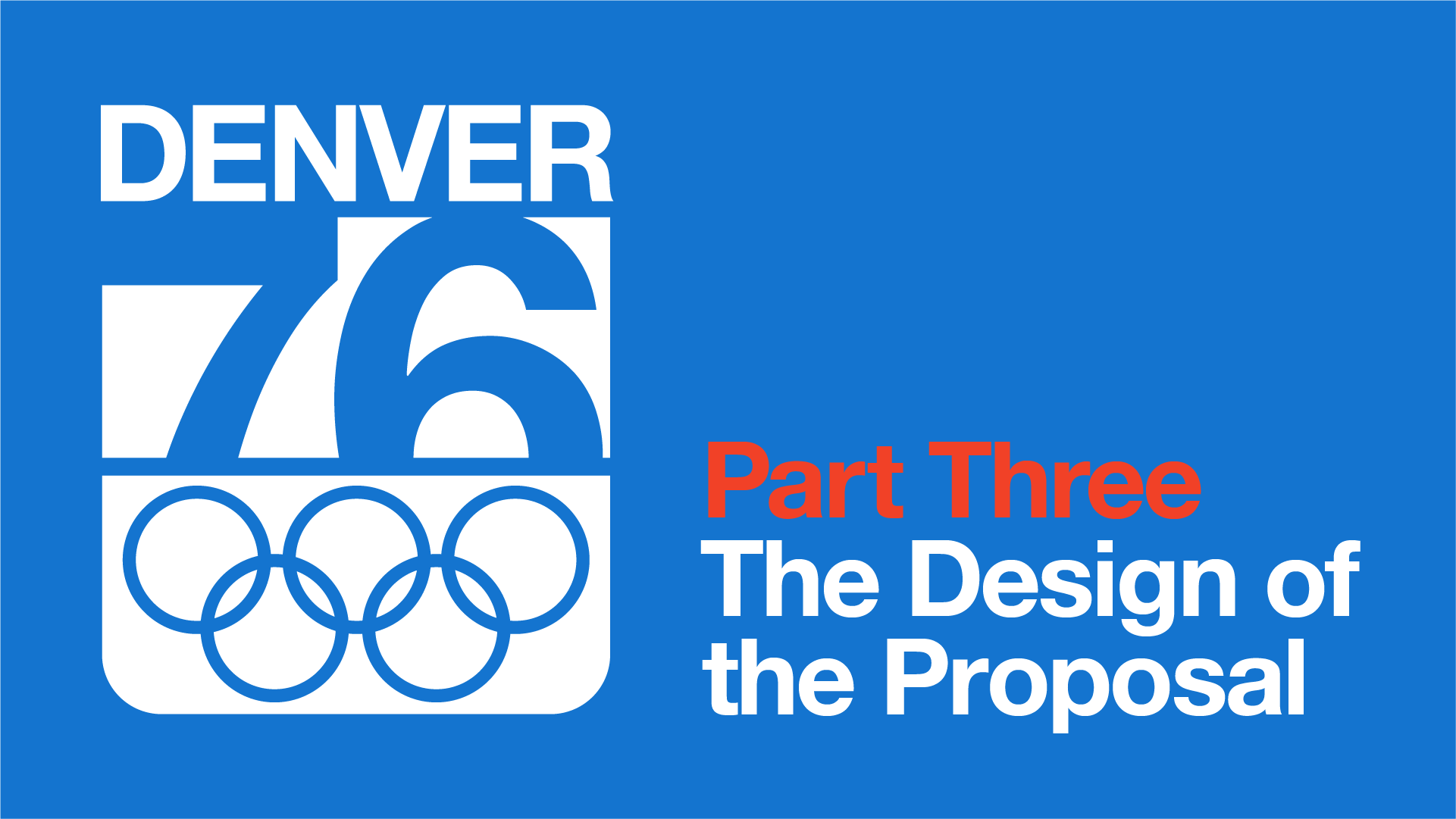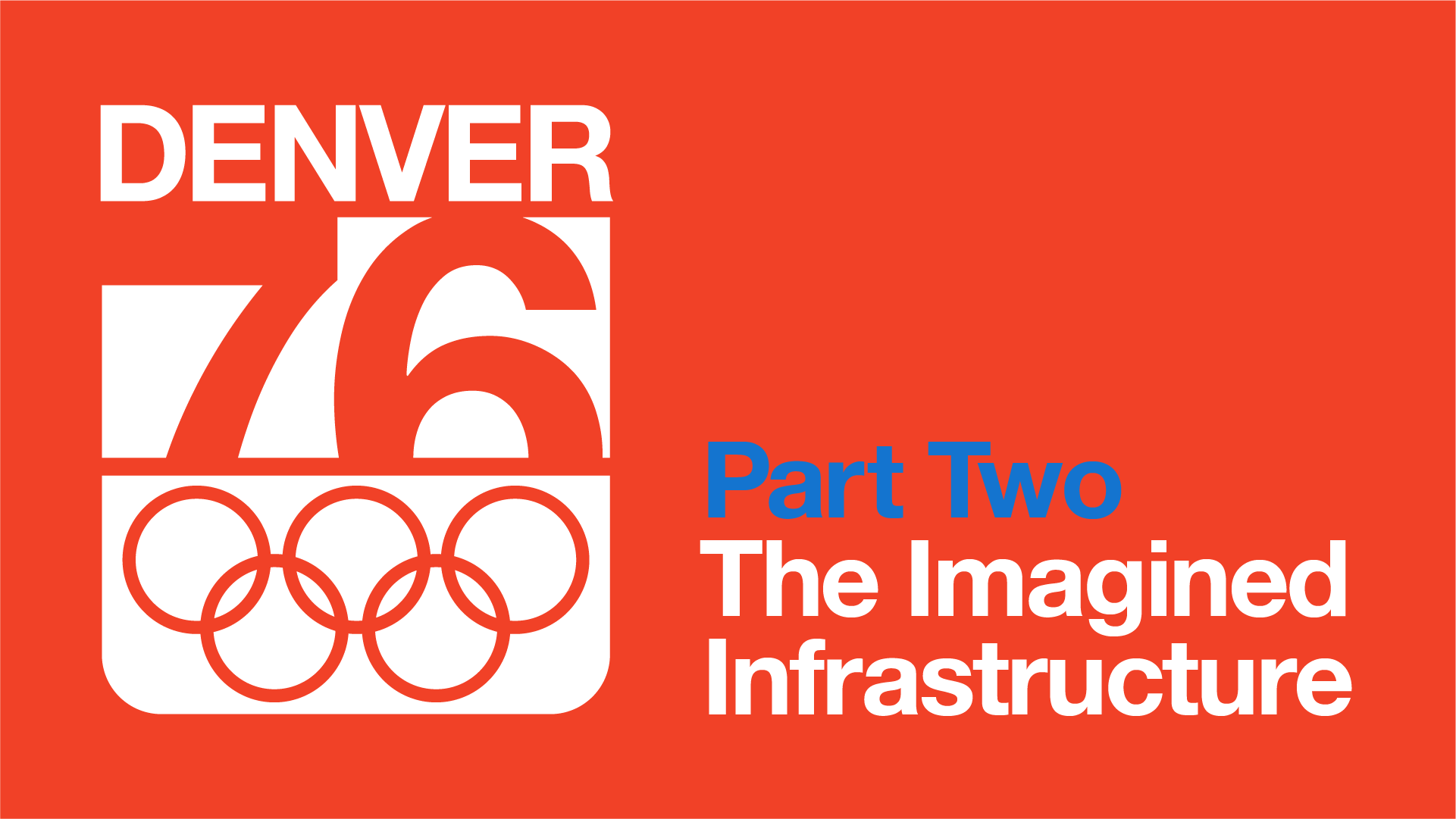
Denver 76 - Part Three: The Design
A visual feast of designs and materials created for the failed Winter Olympics
Published: 10 Nov 2021
Topics: Design, History, Travel
TL;DR: When pitching for the Olympics, you’re going to want to hire the best designers you can. That’s exactly what Denver did, and they made some pretty great stuff.
The Beginning
As I wrote in Part One, this whole blog series about the Olympics being rejected by Denver voters started with a poster that I saw in an antique shop near Denver.

The poster was simple, striking, and obviously professionally designed. Someone had crafted the elements carefully and there was a familiarity to the design that bore the hallmarks of late 1960s modernist design. Although I had never seen this poster before, it just had to have been designed by Massimo Vignelli or one of his contemporaries.
Well, dear Missouri State University, your design history class from over 15 years ago paid off because I was right on the money!
It turns out, this poster was made by the Denver office of Unimark International; the design agency that Vignelli and five other partners founded in 1965, and this poster was just a small part of a much bigger design system for winning the Olympic bid.
Setting Up Shop
According to Jan Conradi’s book “Unimark International: The Design of Business and the Business of Design” the Denver office of Unimark was contracted to create the presentation materials for the Denver Olympic bid by the Denver Organizing Committee (DOC).

The office was started in 1965 by Bob Craig, a Unimark board member, avid skier, and ski instructor. Originally based in Aspen, Craig brought several new clients to Unimark by meeting CEOs on the slopes and talking up the importance of design for their businesses.
In 1967, he moved the office to Denver after signing a major contract with the sugar conglomerate Great Western. Craig’s expertise with skiing and winter sports undoubtedly helped win the contract and help guide the work for the Olympic bid.
Bidding for the Games
I cannot find any documentation for when exactly the Denver office was contracted by the DOC, but I would guess it was in early 1968 after Denver beat out other U.S. cities to become the official candidate for the United States in December, 1967.

Unimark was hired to create all of the materials, exhibitions, films, and plans for the Olympic bid—which was no easy task. This challenge required the entire Denver office along with many people from the other Unimark offices.
The Logo and Poster

Honestly, the logo is perfect in every way. It is easy to read, easy to replicate, and easy to identify from a distance. I cannot find any information on who specifically designed the Denver 76 logo, but it bears all of the hallmarks of Unimark’s design philosophies: simplicity, striking colors, and Helvetica.

When working to create a new, digital version of the Denver 76 logo, I had to trace the logo using a specific version of Helvetica that would have been available during that time. It was all Helvetica Bold, but slightly tweaked.
For the “76” part, I couldn’t find a weight or width that matched the proportions exactly, so my guess is that someone artificially squished the 76 using a photographic method to get the size and negative shapes just right. After all, this is during the “tight not touching” days.

The official poster was created by John Rieben and Guenther Tetz (who worked in the Unimark Chicago office) and many hundreds (if not thousands) were likely printed. I can’t say for sure, but I imagine these posters were put up all over Denver to help promote the Olympic bid.
You can see several copies in this press photo of the DOC officials heading off to Mexico City with these posters in hand. I was told by the owner of the antique shop that the poster I saw hanging on the wall was one of the posters that traveled to Amsterdam for the final presentation.

The Bid Books
Although there were many facets to the Olympic bid, one of the most tangible items created by Unimark is a two volume, large-format book set that was presented to the IOC. These 13×13 inch (32×32 cm) lavishly-illustrated books have color photography, maps, fold-out plans, and information printed in three languages: English, French, and German.

One book was entitled “The City” and focused on the people and infrastructure of Denver while the other book was entitled “Technical Information” and focused on locations and detailed plans. The books were packaged together in a white slipcase and presented to the IOC in Amsterdam during the final presentation.

No expense seems to have been spared in producing these books that have blind-embossed covers with the word “Denver” large at the top and the Denver 76 logo in the bottom left corner. There are fold-out sheets showing diagrams of the various events along with full-page color photography (at a time when full-color printing was prohibitively expensive).





I personally purchased a copy of “The City” and it is clear that an extreme amount of work, planning, and skill went into the layout and production of these books and it obviously made a good impression on the IOC, since Denver was chosen as the host city.
Brochures, Booklets, and Beanies
Along with the bid books and posters, Unimark designed many other materials in support of the bid. Because I’ve not seen these brochures in person, I don’t know what the “International Bulletins” are or what they contain, but the cover designs alone are worth sharing.





And of course, no full identity is complete without proper stationery and business cards. Note that the cable address was Seventysix, which I feel is a pretty good flex.
Recently, I was lucky enough to find a knit beanie on eBay with the Denver 76 logo on it. It is in great shape, but the most awkward size humanly possible and fits terribly on my head. Oh, well—it’s a great start to my collection.

Exhibition in Amsterdam
After starting down this path of researching the Denver bid, I got in contact with Jennifer Whitlock at the Vignelli Archives and she sent along a treasure trove of slides from the Unimark archives.


Among these slides, I kept seeing a few images of what seemed like an exhibition, but I assumed it was something that was set up in Denver to promote the bid. As I looked further, I realized that these photos are most likely from the IOC presentation in Amsterdam that won the games for Denver.


As far as I know, these are never-before-seen images of the presentation booths and you can see how Denver stacked up against Scion, Switzerland and Vancouver, Canada with a peek at the Montréal, Canada booth for the summer 1976 games.

An Official Report
In 1972, the Denver Olympic Committee submitted an official report to the IOC updating them on the progress of the games and planning. I’m not sure if this was a normal, procedural update or if it was requested by the IOC because the discontent from Denver residents was at a fever pitch and had reached all the way back to Lausanne.

This report was typed up with an IBM Selectric typewriter, using different IBM Type Elements for different languages and professional reports. It contained updated plans, diagrams, and information about locations and facilities—all trying to convince the IOC that everything was under control and on-schedule. As history has shown, that was not quite true…

Bonus Material: Posters & Pins!
Like layers of an onion, the Denver 76 story continues to reveal new and interesting items and ephemera. As I was writing this final post, good friend Kyle Read texted me with photos of these posters that I had never seen before. He was visiting his wife’s aunt who lives in South Denver and randomly in her basement were these two posters that she picked up when she got married in 1975.


These posters are not “official” in the sense of being designed by Unimark for the DOC, but “designed and lithographed as a community service by Gene Hoffman and Tewell’s Lithographing Co.”
After some research, I learned that Gene Hoffman was an illustrator that did a ton of amazing work promoting Colorado through his fantastic, groovy visual style in the 1960s and ’70s. You can see more of his work here.

In the same vein is the official Denver 76 pin stuck to a small piece of paper with the sad-trombone phrase of “The Winter Olympics that Never Happened” which was also printed by Tewell’s. It seems like the people at Tewell’s were big fans and likely quite disappointed when Denver was forced to withdraw from hosting the games.
And with that, we have come to the end of this three-part series. I hope you’ve enjoyed reading about it as much as I’ve enjoyed researching and writing it.

